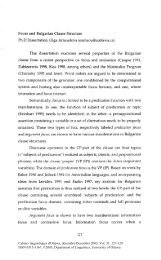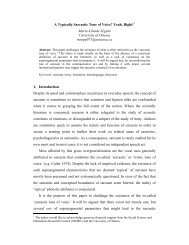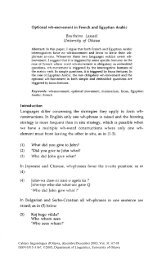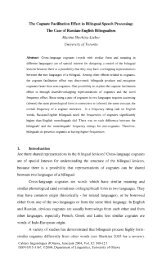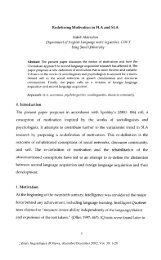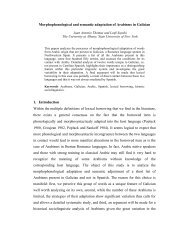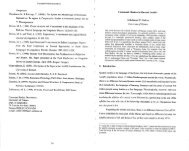Interlingual and Intralingual Interference during Gender Production
Interlingual and Intralingual Interference during Gender Production
Interlingual and Intralingual Interference during Gender Production
Create successful ePaper yourself
Turn your PDF publications into a flip-book with our unique Google optimized e-Paper software.
Denisa Bordag<br />
The experimental session started with a block of 14 practice items, which<br />
was the same for all subjects in each experiment. Each trial started with a visual<br />
fixation point (= * =) presented on a grey background for 600 ms on the right of<br />
the screen in the middle of an imaginary square in which the target picture was<br />
displayed later. Then, either a yellow or a blue background appeared for 300 ms.<br />
The colour of the background defined the language in which the response was<br />
required. Half of the subjects in each experiment had to respond in Czech when a<br />
picture was displayed on a blue background <strong>and</strong> in German when a yellow<br />
background appeared, the other half of the subjects had the colours reversed.<br />
Following this pause, a target picture was presented in the imaginary square on<br />
the right of the computer screen <strong>and</strong> marked with a black arrow pointing at it<br />
from the upper right part of the screen. In the long condition, two pictures of the<br />
same object appeared simultaneously on the screen: The target picture marked<br />
with an arrow on its usual position on the right part of the screen <strong>and</strong> either a<br />
larger or a smaller control picture of the same object on the left. When the left<br />
control picture was larger than the target picture, the subjects had to name the<br />
target picture with the adjective "small"; if the left control picture was smaller<br />
than the target picture, subjects had to name the target picture with the adjective<br />
"big". Naming latencies were measured from the right or both pictures onset by a<br />
voice key.<br />
The display colour of the arrow was contingent on the participant's<br />
response. It turned white as soon as a vocal response was initiated. However, if<br />
no response was registered within 5000 ms (time out) the arrow turned red.<br />
When the participant was ready for the next trial, he or she pressed the space bar<br />
on the keyboard <strong>and</strong> after a pause of 300 ms the fixation point of the new trial<br />
was displayed.<br />
Subjects were r<strong>and</strong>omly assigned to one of two main r<strong>and</strong>omisation<br />
versions in each experiment. Each item was presented in a long <strong>and</strong> in a short<br />
condition. Half of the subjects in each experiment saw the items in the long<br />
condition first; the other half saw the items in the short condition first. Within<br />
each subject, half of the items were long first, the other half were short first. The<br />
10



